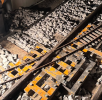Northsider
Modelling the Northern half of the Isle of Man
Not what you were thinking of, but in the spirit of 'a prototype for everything '...
Oh no, that's another oneRhino, Is this what you're talking about? Imgur Video
I like this video, which Patrick also shared. I appreciate the concept of modeling something that actually exists. So, I may do both; the "bridge" and my base design (see post #16) because I also really like the idea of the smaller trains running within the track of the larger. It'd make for a cool photo: my LGB Forney behind my HO GP38-2.Oh no, that's another onenow we've really started something
The one in my muddled head was actually a temporary arrangement, but I can't help thinking that the sugar can example may be a 1:1 example of what we're talking about.
Apparently, railway wheel profiles differ for the proposed speed of the trains involved and, as we know, faster trains use wider radius curves with finer wheel profiles, but I suspect the problem is the same, that the smaller wheels of the sugar cane trucks would struggle to get across the gap
Perhaps treat the crossings like a set of points and have the 16.5mm rails capable of being moved away from the 45mm and then closed when a 16.5mm Train traversesHas anyone tried this sort of thing? I just did a quick SketchUp drawing for what I'm thinking. Ultimately, I want to the LHRR to have its 'full size' engines (running on 45mm track) and its own 1/4 scale engines (my HO stock running on 16.5mm track). My biggest problem I'm coming up with so far is that the flangeway for the 45mm through the HO rails would be way to big for HO trains to be able to safely cross the gap.
Below: my drawing with the flangeway gap (5mm gap) which results in a rail gap of about 25mm for the HO trains to (attemp to) cross. View attachment 338765
Below: No gap for the 45mm track, just to show my drawing.
View attachment 338766
Any thoughts, suggestions are appreciated! Thanks!
You do have one, but you put it away in a safe place that you would easily remember ...I shall add some track to my shopping list... and maybe a Dremel (though, I thought I had one...)
I can guarantee that it will appear no more than ten minutes after the new one is unwrapped...You do have one, but you put it away in a safe place that you would easily remember ...


I love real-world examples, Harry. Thank you for this!Like has been mentioned above by Flying15, A way of moving the 16.5mm rails away from the 45mm rail when the g scale is being run might be the best way. Here is the idea with 5 inch and 2 foot gauge track in Japan. The only issue would be preventing the 16.5 from shorting over the 45mm gauge. maybe an insulated joiner between where the 16.5 rails cross over?View attachment 338880View attachment 338881
You might note that code 250 or code 332 rails can be 16.5mm apart. If you raised the code 100 up to match code 332 rail, you would have a crossing of similar profile rails.ordered some code 100 HO
Ah, the horse-drawn Nantle ?
There is plastic rail made from the 45mm track. I bought several sticks to use on a MoW rail and tie car. I had metal rail cut for it, but it made the car weight ridiculous.Hadn't considered that, Phil. Yes, my plan is to power the HO track. The 45mm won't be powered, but if it is metal it would short the line. Maybe I make a piece out of something else then. 3D printed piece, maybe? just to fit in that space when needed.
Sounds like a plan, but I fear if the HO railhead is low enough to clear the G flanges, there will not be enough clearance in the HO 'four-foot' where it exits from within the G track.What you might like to try is removing the sleepers from the HO track to make it lower to avoid the wheel flanges of the G stock and carefully cut 2 slots out of the G rail to feed the HO track through. It'll take a lot of careful cutting though
